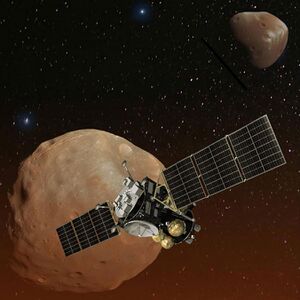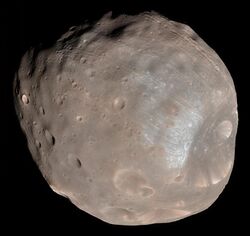Martian Moons Exploration
Topic: Astronomy
 From HandWiki - Reading time: 8 min
From HandWiki - Reading time: 8 min
 An artist’s concept of Japan’s Mars Moons eXploration (MMX) spacecraft, carrying a NASA instrument to study the Martian moons Phobos and Deimos. | |
| Mission type | Sample return |
|---|---|
| Operator | JAXA |
| Website | mmx |
| Mission duration | 5 years (planned) |
| Spacecraft properties | |
| Manufacturer | JAXA [1] |
| Dry mass | Propulsion module: 1800 kg Exploration module: 150 kg Return module: 1050 kg[2] |
| Start of mission | |
| Launch date | September 2024 (planned)[3] |
| Rocket | H3 |
| Launch site | LA-Y, Tanegashima |
| Contractor | Mitsubishi Heavy Industries |
| Phobos lander | |
| Landing date | August 2025[3] |
| Return launch | August 2028[3] |
| Sample mass | ≥10 g (0.35 oz)[4] |
The Martian Moons Exploration (MMX) is a robotic space probe set for launch in 2024 to bring back the first samples from Mars' largest moon Phobos.[3][5] Developed by the Japanese Aerospace Exploration Agency (JAXA) and announced on 9 June 2015, MMX will land and collect samples from Phobos once or twice, along with conducting Deimos flyby observations and monitoring Mars' climate.[6][7]
The mission aims to provide key information to help determine whether the Martian moons are captured asteroids or the result of a larger body hitting Mars. The Japan Aerospace Exploration Agency and other Japanese government officials officially approved the MMX project to proceed into development on 19 February 2020, according to a post on JAXA's website.[8]
Overview
The spacecraft will enter orbit around Mars, then transfer to Phobos,[9] and land once or twice and gather sand-like regolith particles using a simple pneumatic system.[10] The lander mission aims to retrieve a minimum 10 g (0.35 oz) of samples.[4][11] The spacecraft will then take off from Phobos and make several flybys of the smaller moon Deimos before sending the Sample Return Capsule back to Earth, arriving in July 2029.[9][3]
The mission architecture uses three modules: propulsion module (1800 kg), exploration module (150 kg) and the return module (1050 kg).[2] With the mass of Deimos and Phobos being too small to capture a satellite, it is not possible to orbit the Martian moons in the usual sense. However, orbits of a special kind, referred to as quasi-satellite orbits, can be sufficiently stable to allow many months of operations in the vicinity of the moon.[2][12][13]
The mission leader is Yasuhiro Kawakatsu.[14].
International collaboration
NASA, ESA, and CNES[15] are also participating in the project, and will provide scientific instruments.[16][17] The U.S. will contribute a neutron and gamma-ray spectrometer called MEGANE (an acronym for Mars-moon Exploration with GAmma rays and NEutrons, which also means "eyeglasses" in Japanese),[9][18] and France (CNES) the Near IR Spectrometer (NIRS4/MacrOmega).[11][19] France is also contributing expertise in flight dynamics to plan the mission's orbiting and landing manoeuvres.[10]
Development and testing of key components, including the sampler, is ongoing.[20] As of 2020, MMX is scheduled to be launched in September 2024, and will return to Earth five years later.
Scientific payload
The scientific payload consists on Japanese and international contributions. They will be powered by solar arrays.[3]
- Gamma rays and Neutrons Spectrometer (MEGANE meaning "eyeglasses" in Japanese) - developed by NASA
- Wide Angle Multiband Camera (WAM)
- Near-Infrared Spectrometer (MacrOmega) - developed by CNES, France.
- Optical Radiometer composed of Chromatic Imagers (OROCHI)
- Telescopic Nadir Imager for Geomorphology (TENGOO)
- Light Detection and Ranging (LIDAR)
- Circum-Martian Dust Monitor (CMDM)
- Mass Spectrum Analyzer (MSA)
Additionally, the Gravity GradioMeter (GGM), Laser-Induced Breakdown Spectroscope (LIBS), Mission Survival Module (MSM) were proposed as additional instruments.[21]
Following a study by the French CNES space agency,[10] it was decided that the spacecraft will deliver a small rover provided by CNES and the German Aerospace Center (DLR). The rover will be equipped with cameras, a radiometer, and a Raman spectrometer for in-situ surface exploration of the Martian moon.[22]
Sampling
MMX's sampler is equipped with two sampling methods: the Coring Sampler (C-SMP) to gain regolith at depths deeper than 2 cm from the Phobos surface, and the Pneumatic Sampler (P-SMP) from the Phobos surface. The robotic arm will collect regolith from the ground by shooting the C-SMP mechanism. The C-SMP mechanism is designed to rapidly perform subsurface sampling to collect over 10 grams of the regolith. It is equipped with an ejecting actuator that uses a special shape memory alloy, SCSMA [23]. P-SMP that is installed nearby the footpad of the landing leg uses an air gun to puff pressurised gas, pushing about 10 grams of soil into the sample container.[24] Both C-SMP and P-SMP can collect samples quickly because the entire sampling procedure shall be performed only in 2.5 hours.
After taking off from the landing site, the equipped robotic arm transfers both C-SMP and P-SMP canister to the sample return capsule. The spacecraft will then take off from Phobos and make several flybys of the smaller moon Deimos before carrying the Sample Return Capsule back to Earth, arriving in July 2029.[9][3]
See also
- Astronomy:List of missions to Mars – None
- Engineering:Nozomi (spacecraft) – Failed Mars orbiter
- Proposed missions to Mars' moons
- Astronomy:Phobos Surveyor – Proposed Phobos orbiter
- Astronomy:Phobos program – 1988 Soviet missions to Mars
- Astronomy:Phootprint – Proposed sample-return mission to Phobos
References
- ↑ https://spaceflightnow.com/2020/02/20/phobos-sample-return-mission-enters-development-for-2024-launch/ - 20 February 2020
- ↑ 2.0 2.1 2.2 Japanese mission of the two moons of Mars with sample return from Phobos. Hirdy Miyamoto, University of Tokyo. 2016.
- ↑ 3.0 3.1 3.2 3.3 3.4 3.5 3.6 MMX Homepage. JAXA, 2017
- ↑ 4.0 4.1 Gravity both too strong and too weak: landing on the Martian moons. JAXA News. 31 August 2017
- ↑ "JAXA plans probe to bring back samples from moons of Mars". 10 June 2015. http://www.japantimes.co.jp/news/2015/06/10/national/science-health/jaxa-plans-probe-bring-back-samples-martian-moons/.
- ↑ "Observation plan for Martian meteors by Mars-orbiting MMX spacecraft" (PowerPoint). June 10, 2016. https://www.cosmos.esa.int/documents/653713/1049906/08+Yamamoto20160610.ppt/1d540dc8-5053-4732-8af1-db6be0c5ae4e. Retrieved 2017-03-23.
- ↑ "A giant impact: Solving the mystery of how Mars' moons formed". ScienceDaily. July 4, 2016. https://www.sciencedaily.com/releases/2016/07/160704144236.htm. Retrieved 2017-03-23.
- ↑ https://spaceflightnow.com/2020/02/20/phobos-sample-return-mission-enters-development-for-2024-launch/ - 21 February 2020
- ↑ 9.0 9.1 9.2 9.3 NASA confirms contribution to Japanese-led Mars mission. Stephen Clark, Space Flight Now. 20 November 2017.
- ↑ 10.0 10.1 10.2 How to find the best samples on a moon: Building relationships and solving engineering challenges in France. JAXA News, 4 December 2017.
- ↑ 11.0 11.1 Fujimoto, Masaki (January 11, 2017). "JAXA’s exploration of the two moons of Mars, with sample return from Phobos" (PDF). Lunar and Planetary Institute. http://www.lpi.usra.edu/sbag/meetings/jan2017/presentations/Fujimoto.pdf. Retrieved 2017-03-23.
- ↑ Quasi-Satellite Orbits around Deimos and Phobos motivated by the DePhine Mission Proposal. (PDF) Sofya Spiridonova, Kai Wickhusen, Ralph Kahle, and Jürgen Oberst. DLR, German Space Operations Center, Germany. 2017.
- ↑ Orbit Maintenance of Quasi-Satellite Trajectories via Mean Relative Orbit Elements. Nicola Baresi, Lamberto Dell'Elce, Josué Cardoso dos Santos, and Yasuhiro Kawakatsu. IAC, International Astronautical Congress, Bremen, Germany, 2018.
- ↑ Kawakatsu Lab Homepage. Deep Space Mission Design Laboratory (DSMDL), Institute of Space and Astronautical Science (ISAS)/JAXA, 2017
- ↑ "Coopération spatiale entre la France et le Japon Rencontre à Paris entre le CNES et la JAXA-ISAS" (PDF) (Press release) (in French). CNES. February 10, 2017. Retrieved March 23, 2017.CS1 maint: unrecognized language (link)
- ↑ "ISASニュース 2017.1 No.430" (in Japanese) (PDF). Institute of Space and Astronautical Science. 22 January 2017. http://www.isas.jaxa.jp/outreach/isas_news/files/ISASnews430.pdf.
- ↑ Green, James (June 7, 2016). "Planetary Science Division Status Report" (PDF). Lunar and Planetary Institute. http://www.lpi.usra.edu/pss/jun2016/presentations/Green.pdf#page=22. Retrieved 2017-03-23.
- ↑ Back to the Red Planet. Johns Hopkins APL. 17 November 2017.
- ↑ "A STUDY OF NEAR-INFRARED HYPERSPECTRAL IMAGING OF MARTIAN MOONS BY NIRS4/MACROMEGA ONBOARD MMX SPACECRAFT" (PDF). Lunar and Planetary Institute. March 23, 2017. http://www.lpi.usra.edu/meetings/lpsc2017/pdf/2813.pdf. Retrieved 2017-03-23.
- ↑ "ISASニュース 2016.7 No.424" (in Japanese) (PDF). Institute of Space and Astronautical Science. 22 July 2016. http://www.isas.jaxa.jp/outreach/isas_news/files/ISASnews424.pdf#page=6.
- ↑ Ozaki, Masanobu; Shiraishi, Hiroaki; Fujimoto, Masaki (5 January 2017). "火星衛星探査計画(MMX)の科学観測装置" (in Japanese). JAXA. https://repository.exst.jaxa.jp/dspace/handle/a-is/609951.
- ↑ DLR. "DLR Press Portal" (in en). https://www.dlr.de/dlr/presse/en/desktopdefault.aspx/tabid-10172/213_read-36252/.
- ↑ Hiroki Kato, Yasutaka Satou, Kent Yoshikawa, Masatsugu Otsuki, and Hirotaka Sawada, (2020), Subsurface Sampling Robot for Time-limited Asteroid Exploration, Proceedings of IEEE/RSJ International Conference on Intelligent Robots and Systems (IROS), Las Vegas, October 2020. (to be appeared)
- ↑ Preparing for the unexpected: a second way to sample a moon. Yasutaka Satou, JAXA News. 25 October 2017.
 KSF
KSF



